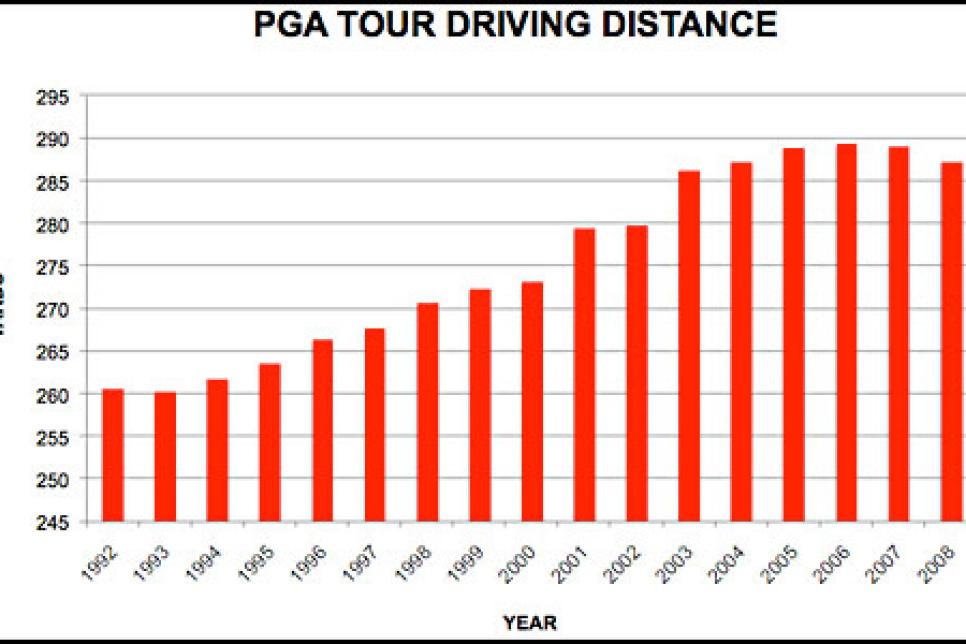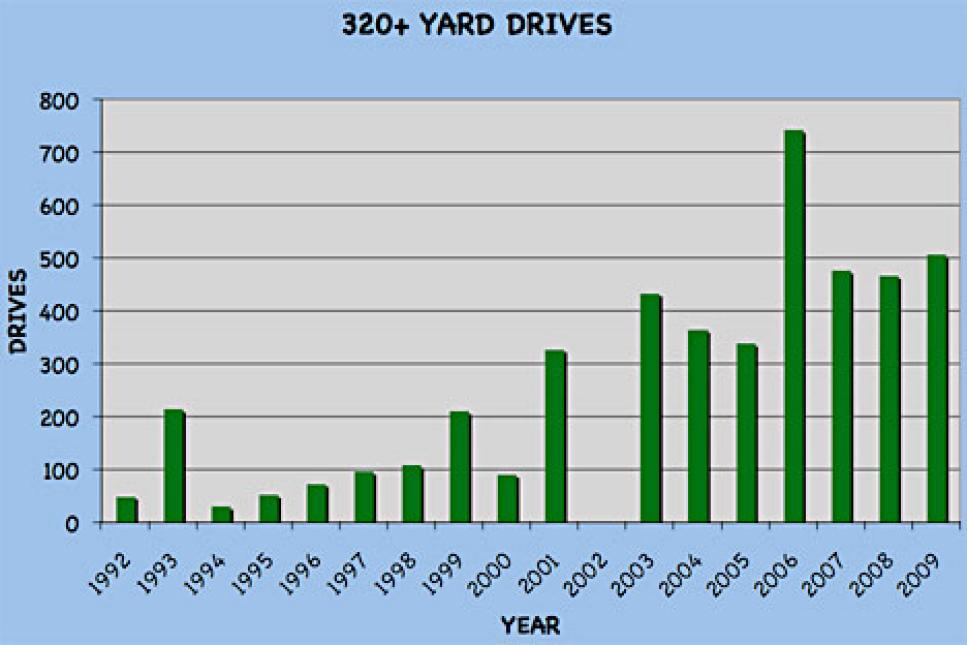News
Long And Wrong

While Alvaro Quiros' prodigious drives suggest technology needs to be reeled in, the Spaniard has actually been the exception to the rule
The unfortunate nature of journalism is that it very nearly requires elevating the most trivial of current events to near cataclysmic proportions. This would explain, for example, CNBC. Or, more precisely, TMZ.com.
Golf's latest version of this sense of the onrushing apocalypse is Alvaro Quiros, the new driving distance king of the PGA Tour, who topped the field driving distance average by 37 yards last week at the Transitions Championship, and is averaging about six more yards off the tee than anybody playing golf on the planet right now (312.3 on the PGA Tour, 314.2 on the European Tour, and about 398 when he really lets out the shaft). An example: He drove it 30 yards over the green on the second hole at Doral's Blue Monster course. The hole measures 376 yards.
Quiros' exploits, naturally, have golf's familiar reactionaries decrying the game's out-of-control distance explosion and wondering if this is the evidence the ruling bodies need to implement their next technology rollback, presumably the golf ball.
To be sure, the USGA has indicated that its research on golf ball distance, first announced in March 2005, is ongoing. The thrust of that research involves studying balls that would be 15 to 25 yards shorter than current models. But the timeline for the project is long, according to USGA senior technical director Dick Rugge.
"The ball project has not been backburnered," he told GolfDigest.com recently. "We're doing a lot of testing with players."
Last August when the USGA announced the rule change for grooves that will go into effect on the PGA Tour next year, Rugge and others credited the statistical evidence from the PGA Tour's ShotLink as "very helpful" in formulating ideas about how the game was being played at the elite level. And when it comes to the issue of distance, Rugge also points to PGA Tour statistics.
"We have seen over the last five years that driving distance has remained stable, and we expect it to stay that way," he said.
Anything but stable is Quiros' 124.5-mile-per-hour clubhead speed, which also leads the PGA Tour. He's one of 32 players on tour whose driver speed is more than 115 miles per hour this year. To further put that in perspective, the average swing speed on tour now is a little over 111 miles per hour. That's two miles per hour faster than the speed the USGA previously used to test golf balls in the Overall Distance Standard test, a speed meant to reflect what the fastest clubhead speeds on tour might be. That number was adjusted to 120 miles per hour in 2004.
Of course, if you're given to speculation, those speeds might sound like so many hoofbeats of the apocalypse. But it's not that simple.
After a 23-yard boost from 1995 to 2003, the tour distance number has been relatively unchanged the last six seasons. Since 2003, it's been as high as 289.6 (2006) and as low as 286.3 (2003), but has actually dipped each of the last two years. Through 13 events this year, the number is 283.7, or slightly ahead of last year's pace. But let's dig a little deeper.

The PGA Tour has tracked longest drives since 1992, and those numbers are about as powerful as Alvaro Quiros' 180-mile-per-hour ballspeed. Call it the Bomb Average. Comparing the number of 320-yard drives recorded on the two measured driving distance holes each week in each year's first 13 events, there's a spectacular shift upward in big hits since 2001. From 1992-2000, the Bomb Average was about 100 for the first three months of the year, but in four of those nine years the number of 320-yard drives was less than 75. Ever since, including 2009, the Bomb Average is more than 450. That's right. In the first 13 events of the year from 2001 to 2009, tour players are averaging four times as many 320-yard or longer drives than they did in the previous nine seasons. That's earth-shaking.
Still, there are questions. If PGA Tour driving distance average is not budging, is it fair to suggest that distance on the elite level is capped?
If no, then how much more is left out there? We went to those who seemingly would have the most to gain from statistical displays of technology's impact on golf to see what to make of the number: the equipment industry. Their opinions, curiously, were mixed. Most believe technology's role in the future is somewhat limited, thanks to the rules.
Specifically, Wally Uihlein, CEO and Chairman of the Acushnet Company, cited "the most activist 10-year period in the history of golf ball and golf club regulation," along with "the S-Curve of invention maturity" as the primary causes for flatlining tour driving distance.
"A very 'bold and rigid' line in the sand has been effectively drawn by the game's regulatory bodies," he wrote in an e-mail to GolfDigest.com. "The statistics since then speak for themselves. The USGA and R&A have effectively fenced in the driver and golf ball, so that there is little or no more distance to be had from equipment under the current rules and regulations."

He wasn't done. To those calling for a golf ball rollback, Uihlein suggested the ball's distance gains through technological advances are "already 98 percent downfield toward reaching the absolute Overall Distance Standard limit (including the tolerance)" for perhaps as much as a five- to seven-yard potential increase in total yards.
"The bottom line is when you attempt to tweak a golf ball parameter for more distance," he said, "other parameters are affected that limit the distance opportunity."
Uihlein believes the driver is even more restricted. His sense, ultimately, is that technologically the game has reached its limit.
"The facts are the facts, and any suggestion of dramatic yardage spikes going forward is either disingenuous or propagandist. Take your pick."
Of course, one man's propaganda is another man's potential. Benoit Vincent, Chief Technology Officer at TaylorMade Golf, believes there's 25 yards still on the table from a technological standpoint. Whether it gets co-opted by elite players is another question, however, he said.
"We've seen the gains of the past 15 years on tour because players could take advantage of the technology without having to compromise in terms of technique or dispersion," he said, citing specifically the changes in shaft length, driver ballspeed and ball construction. "Because the tour players will have to place some weight on accuracy, much more than the average player will, they may choose to sacrifice some distance."
Vincent's point: Most tour players won't see performance gains based on driver technology unless they opt for a longer shaft. Interestingly, Quiros uses a 45½-inch shaft, only slightly longer than the tour average. Like Vincent, Jeff Colton, senior vice president of research and development at Callaway Golf, thinks that means average hackers will see the larger gains from technology in the future.
"Today's innovations in drivers provide more benefit to the average golfer than it does to the tour professional," Colton said. "They aren't getting as much benefit because they aren't hitting it anywhere but the center of the face."
He offers a different theory about the future of distance on the PGA Tour, but one no less shocking for golf's gatekeepers. "I think the tour is going to continue to increase its distance over time, but it will be driven more by athleticism than equipment."
Colton predicts distance gains in golf could be similar to the athletic improvement in other individual sports like track and field. Colton says distance in golf has improved at a rate of 0.4 percent a year. Using that math, he suggests that by the year 2030 the top five longest hitters on the PGA Tour will average about 340 yards off the tee, while the bottom five hitters on the PGA Tour would average around 296 yards. But, he says, athletes in track and field, swimming and other similar individual sports tend to improve at a rate of 0.76 percent per year. If golf could match that rate, he says the top five long hitters would average 366 yards by the year 2030, and the shortest would be averaging 318. Or six yards more than Alvaro Quiros.
"My point is the game is going to be different in 20 years," Colton said. "Speed is all a function of strength and leverage. The more power I put into the system, the faster I swing the golf club.
"Bottom line: They're going to hit it farther because they're in the gym."
You can argue whether the ever-escalating improvement theory, as statistically valid as it seems, is even possible in golf. Certainly, the numbers for driving distance seem to work both sides of the street, given that driving distance average has steadied over the last six seasons while the number of 320-yard drives has increased 55 percent since 2001.
But Colton suggests that if such improvement appears to be happening, the game's only option may be to set up different equipment rules for elite players, much like the wooden bat rule used in Major League Baseball.
"Tiger was the tipping point as far as athleticism in golf goes, and as long as the purses continue to increase, the sport is going to continue to draw more and more better athletes. Golfers are going to continue to train harder. It's going to happen over time. And this is going to be an issue that the ruling bodies are going to have to deal with."
Statistics source: PGA Tour ShotLink

.jpg)